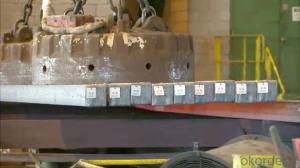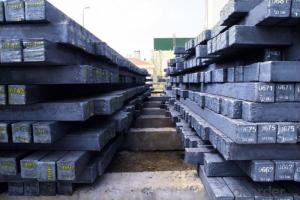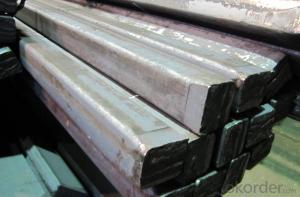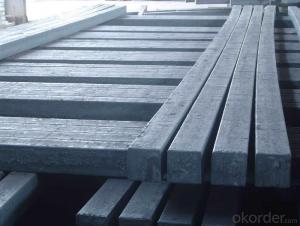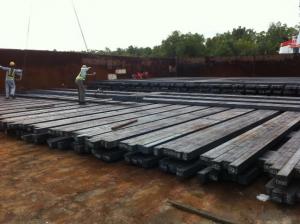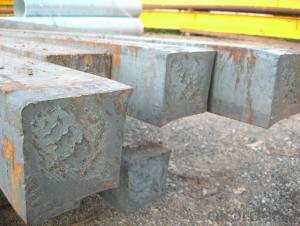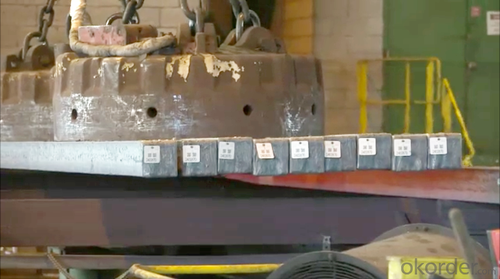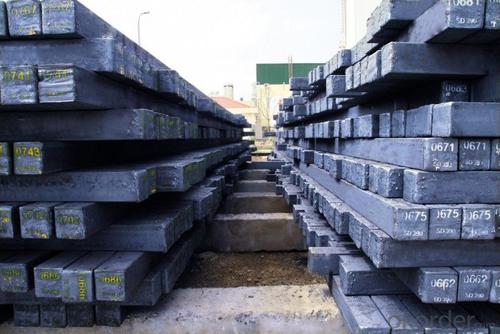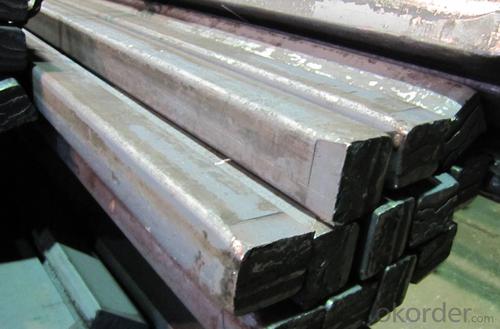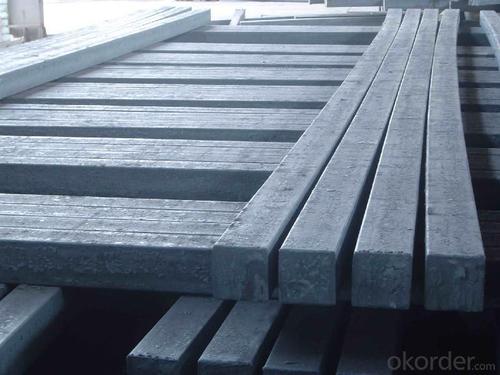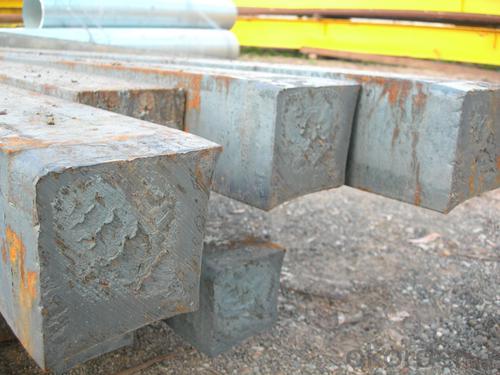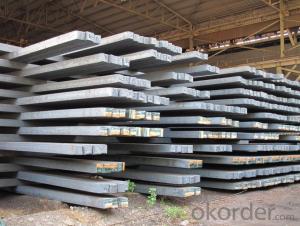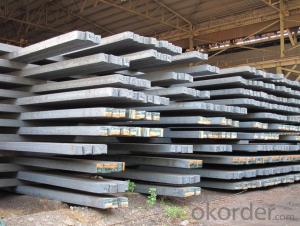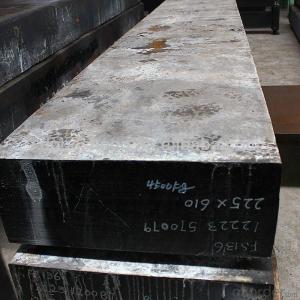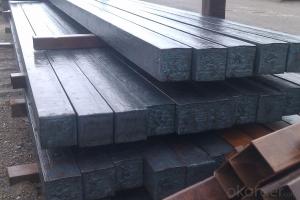Hot Rolled Square Steel Billet 3SP Standard 145mm
- Loading Port:
- Shanghai
- Payment Terms:
- TT OR LC
- Min Order Qty:
- 2000 m.t.
- Supply Capability:
- 10000 m.t./month
OKorder Service Pledge
OKorder Financial Service
You Might Also Like
Structure of Hot Rolled Square Steel Billet 3SP Standard 145mm
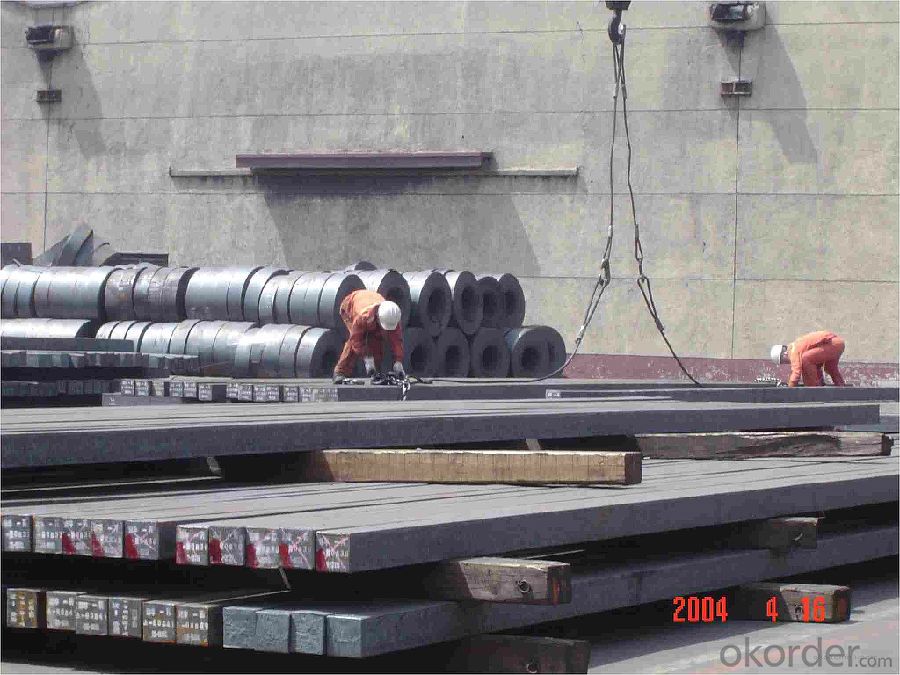
Description of Hot Rolled Square Steel Billet 3SP Standard 145mm
PPGI is made by cold rolled steel sheet and galvanized steel sheets as baseplate, through the surface pretreatment (degreasing, cleaning, chemical conversion processing), coated by the method of continuous coatings (roller coating method),
and after roasting and cooling. Zinc coating: Z60, Z80, Z100, Z120, Z180, Z275, G30, G60, G90
Alu-zinc coating: AZ60, AZ80, AZ100, AZ120, AZ180, G30, G60, G90
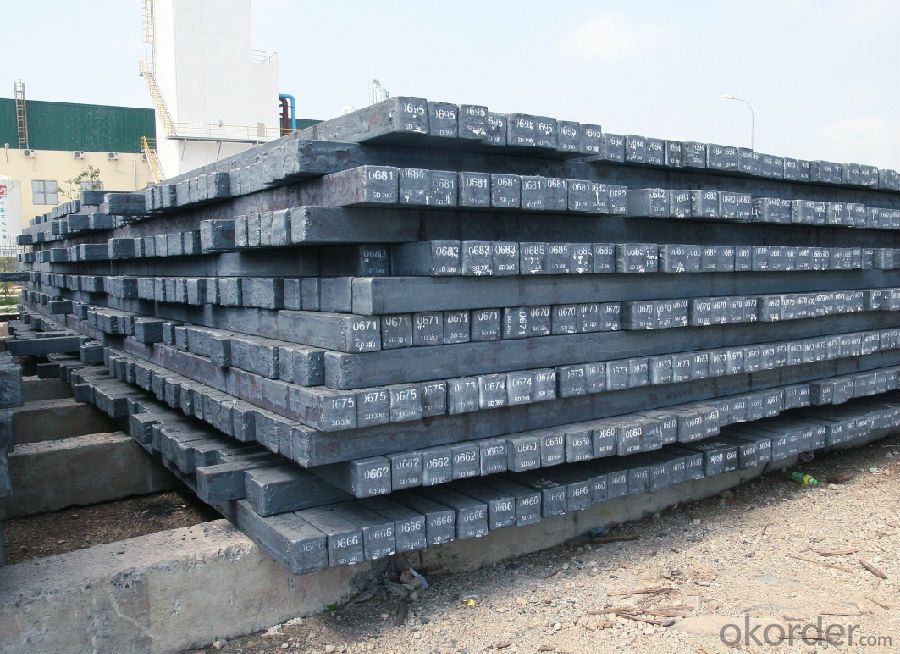
Main Feature of Hot Rolled Square Steel Billet 3SP Standard 145mm
1) Excellent corrosion resistance: The zinc layer provides a good protection of Pre-painted Galvanizeed Steel Sheet.
2) High heat resistance: The reflective surface of the material aids in efficiently reflecting the sunlight away and in turn reducing the amount of heat transmitted. The thermal reflectivity converts into energy savings.
3) Aesthetics: Pre-Painted Galvanized steel sheet is available in plethora of patterns and multiple sizes as per the requirements that given by our customers.
4) Versatility: can be used in the various areas.Standard seaworthy export packing: 3 layers of packing, inside is kraft paper, water plastic film is in the middle and outside GI steel sheet to be covered by steel strips with lock, with inner coil sleeve.
Applications of Hot Rolled Square Steel Billet 3SP Standard 145mm
1) Automotive bodies: filters, fuel tanks, etc.
2) Construction materials: roofings, welding pipes,
3) Electric and electronic appliances: computer cans, etc.
4) Steel cans: containers, etc.
5) Steel furniture: washing machines, refrigerators, microwaves, etc.
6) Drums
7) Office equipment: printer, recorders, etc.
8) Motors and transformers
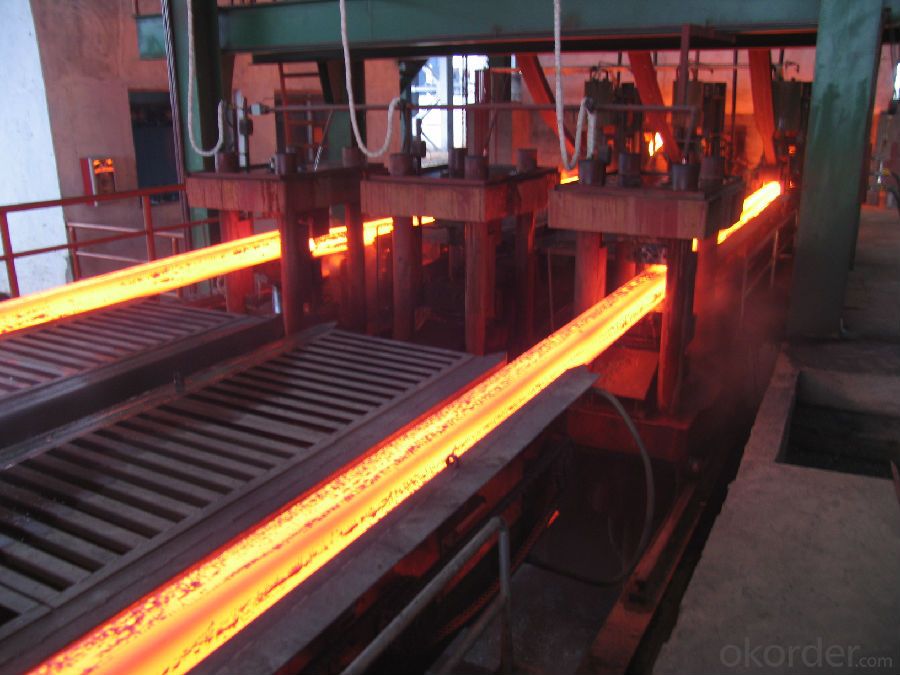
Specifications of Hot Rolled Square Steel Billet 3SP Standard 145mm
| Classified symbol | Yield Point Minimum N/mm2 | Tensile Strength Minimum | Elongation Minimum % | Application | ||||
| N/mm2 | Nominal Thickness mm (t) | |||||||
| JIS | Yogic | 0.25-0.4 | 0.4-0.6 | 0.6-1.0 | 1.0-1.6 | |||
| G3312 | specification | |||||||
| CGCC | CGCC | -205 | -270 | -20 | -21 | -24 | -24 | Commercial |
| CGCD | CGCD | --- | 270 | --- | 27 | 31 | 32 | Drawing |
| --- | CG340 | 245 | 340 | 20 | 20 | 20 | 20 | Structural |
| CGC400 | CG400 | 295 | 400 | 16 | 17 | 18 | 18 | Structural |
| CGC440 | CG440 | 335 | 440 | 14 | 15 | 16 | 18 | Structural |
| CGC490 | CG490 | 365 | 490 | 12 | 13 | 14 | 16 | Structural |
| CGC570 | CG570 | 560 | 570 | --- | --- | --- | --- | Structural |
| ASTM Designation | Yield Point Minimum | Tensile Strength Minimum | Elongation Minimum % | Application | Q/BQB 445-2004(China standard) | ASM A653/A653M | JISG 3312 | |
| ksi(MPa) | ksi(MPa) | TDC51D+Z | (CS TYPE A+Z) | CGCC | ||||
| A653(M)-99 CS TYPE A,B,C | --- | --- | --- | Commercial | TDC52D+Z | CGCD | ||
| A653(M)-99 FS | --- | --- | --- | Lock Forming | TS250GD+Z | (G250+Z) | - | |
| A653(M)-99 DS | --- | --- | --- | Drawing | TS300GS+Z | (G300+Z) | CGC 400 | |
| A653(M)-99 SS Grade33(230) | 33(230) | 45(310) | 20 | Structural | TS350GD+Z | (G350+Z) | CGC490 | |
| A653(M)-99 SS Grade37(255) | 37(255) | 52(360) | 18 | Structural | TS550GD+Z | (G550+Z) | CGC570 | |
| A653(M)-99 SS Grade40(275) | 40(275) | 55(380) | 16 | Structural | ||||
| A653(M)-99 SS Grade50(345) | 50(345) | 65(450) | 12 | Structural | ||||
| A653(M)-99 SS Grade80(550) | 80(550) | 82(570) | --- | Structural | ||||
FAQ of Hot Rolled Square Steel Billet 3SP Standard 145mm
We have organized several common questions for our clients,may help you sincerely:
1. How Can I Visit There?
Our company is located in Tianjin City, China, near Beijing. You can fly to Tianjin Airport Directly. All our clients, from home or aboard, are warmly welcome to visit us!
2. How Can I Get Some Sample?
We are honored to offer you sample.
3. Why choose CNBM?
1, ISO, BV, CE, SGS approved.
2, Competitive price and quality.
3, Efficient service team online for 24 hours.
4, Smooth production ability(50000tons/month) .
5, quick delivery and standard exporting package.
6, Flexible payment with T/T, L/C, Paypal, Kunlun bank, etc.
- Q: What are the causes of internal cracks in continuous casting billet?
- A French Research Institute of carbon, sulfur and phosphorus influence on continuous casting billet hot cracking, a total of three test groups of carbon manganese steel, carbon, sulfur and phosphorus content of each sample is different. The test according to the process of the sample for cooling, in order to study the effects of the three elements of the internal crack of continuous casting billet hot.
- Q: How are steel billets cut into smaller pieces?
- Steel billets are typically cut into smaller pieces through a process called sawing or shearing. There are various methods used to achieve this, depending on the desired size and precision of the cuts. One common method is using a saw blade, either circular or band saws, which are specifically designed for cutting through metal. These saws can be manually operated or automated, depending on the scale of the operation. The billets are clamped securely to prevent movement, and the saw blade is guided along the marked cutting line, gradually slicing through the steel to create smaller pieces. Another approach is shearing, which involves using a shear machine to apply intense force to cut through the billet. This method is often used for thicker billets or when precise cuts are not necessary. The shear machine consists of a fixed blade and a moving blade that come together to sever the billet along the desired cutting line. Additionally, advanced technologies like laser cutting or plasma cutting can also be employed to cut steel billets into smaller pieces. These methods utilize high-powered lasers or plasma jets to melt or vaporize the material along the cutting line, resulting in a clean and precise cut. Overall, the choice of cutting method depends on factors such as the thickness of the billet, the desired precision of the cuts, and the production capacity. Regardless of the method used, safety precautions are always taken to ensure the well-being of the operators and to maintain the quality of the cut steel pieces.
- Q: How are steel billets used in the manufacturing of medical devices?
- Steel billets are used in the manufacturing of medical devices in various ways. Firstly, steel billets serve as a raw material for the production of surgical instruments, such as scalpels, forceps, and scissors. These devices require a high level of strength, durability, and corrosion resistance, which steel billets can provide. Additionally, steel billets are used in the manufacturing of implants, such as joint replacements and dental implants. These devices need to be able to withstand the load and stress exerted by the human body, and steel billets are an ideal material due to their excellent mechanical properties. Moreover, steel billets are used in the production of medical equipment, such as hospital beds, wheelchairs, and surgical tables. These devices require a sturdy and robust structure, and steel billets can provide the necessary strength and stability. Furthermore, steel billets are also utilized in the manufacturing of medical equipment components, such as brackets, frames, and supports. These components play a crucial role in the functioning and stability of medical devices, and steel billets are often chosen due to their high machinability and weldability. Overall, steel billets are an essential raw material in the manufacturing of various medical devices. Their strength, durability, corrosion resistance, and other mechanical properties make them a suitable choice for producing surgical instruments, implants, medical equipment, and their components.
- Q: How are steel billets used in the manufacturing of renewable energy equipment?
- Steel billets are used in the manufacturing of renewable energy equipment as a primary raw material. These billets are shaped and processed to create various components such as wind turbine towers, solar panel frames, and hydroelectric power structures. The strong and durable nature of steel allows for the construction of robust and long-lasting renewable energy equipment, ensuring their reliability and performance in harnessing sustainable energy sources.
- Q: Are steel billets affected by extreme temperatures?
- Yes, steel billets are affected by extreme temperatures. When exposed to high temperatures, steel billets can expand and deform. This is due to the thermal expansion property of steel, where it expands in size as it is heated. On the other hand, when subjected to extremely low temperatures, steel billets can contract and become more brittle. This is because the cold temperature reduces the ductility of steel, making it more prone to fracture. Therefore, it is crucial to consider the effect of extreme temperatures on steel billets when designing, handling, and storing them to prevent any unwanted deformation or failure.
- Q: What are the properties of alloy steel billets?
- Alloy steel billets are highly sought after in various industries due to their numerous desirable properties. Chief among these is their exceptional strength and toughness, which is attributed to the presence of alloying elements like chromium, nickel, molybdenum, and vanadium. This heightened strength enables the billets to withstand heavy loads and high temperatures, making them ideal for applications that demand resistance to wear and tear. Furthermore, alloy steel billets possess excellent corrosion resistance, rendering them perfect for use in harsh environments or exposure to chemicals. This resistance to corrosion not only extends the lifespan of the billets but also ensures their durability over time. Moreover, alloy steel billets exhibit good machinability, allowing them to be easily shaped, formed, and fabricated into various products or components. This quality facilitates the creation of intricate and complex designs, making them versatile for use in automotive, construction, and manufacturing industries. Another noteworthy property of alloy steel billets is their ability to undergo heat treatment. This process enables the adjustment of their mechanical properties, such as hardness and ductility, to meet specific requirements. Heat treatment enhances the strength and toughness of the billets, making them even more suitable for heavy-duty applications. Lastly, alloy steel billets possess excellent weldability, enabling them to be easily joined together through various welding techniques. This characteristic adds to their versatility and allows for the construction of larger structures or the fabrication of complex assemblies. In conclusion, the properties of alloy steel billets, including strength, corrosion resistance, machinability, heat treatability, and weldability, make them extremely valuable in industries where high performance and durability are crucial.
- Q: What are the specifications for tool steel billets used in the manufacturing of cutting tools?
- The specifications for tool steel billets used in the manufacturing of cutting tools typically include factors such as high hardness, excellent wear resistance, good toughness, and high strength. Additionally, specific alloying elements and heat treatment processes are employed to enhance the performance and durability of the cutting tools.
- Q: What are the potential defects or flaws in steel billets?
- There are several potential defects or flaws that can occur in steel billets, which can affect the quality and performance of the final product. Some of these defects include: 1. Surface defects: Steel billets can develop surface cracks, scales, or scratches during the manufacturing process. These defects can weaken the material and reduce its structural integrity. 2. Internal defects: Inclusions, such as non-metallic impurities or gas bubbles, can be present within the steel billets. These internal defects can cause localized weaknesses and reduce the overall strength of the material. 3. Segregation: Uneven distribution of alloying elements or impurities can lead to segregation, where certain areas of the billet have different chemical compositions. Segregation can result in inconsistent mechanical properties across the material and decrease its uniformity. 4. Central segregation: This defect occurs when there is a concentration of impurities or alloying elements in the central region of the billet, leading to a weaker core. Central segregation can cause structural failures and reduce the overall reliability of the steel billet. 5. Shrinkage cavities: During the solidification process, shrinkage cavities can form in the steel billet due to the contraction of the molten metal. These cavities can weaken the material and compromise its structural integrity. 6. Surface decarburization: Exposure to high temperatures or improper heat treatment can cause the surface of the steel billet to lose carbon content, resulting in surface decarburization. This defect can reduce the hardness and strength of the material. 7. Laminations: Laminations are thin, elongated voids or layers that can form parallel to the surface of the billet. These defects can weaken the material and make it prone to cracking or failure under stress. 8. Internal cracks: Internal cracks can occur due to improper cooling or handling of the billet during the manufacturing process. These cracks can compromise the structural integrity of the steel billet and potentially lead to catastrophic failure. It is important to detect and address these defects early on to ensure the quality and reliability of the steel billets. Various non-destructive testing techniques, such as ultrasonic testing or magnetic particle inspection, can be utilized to identify and mitigate these potential flaws.
- Q: What are the different types of surface coating methods used for steel billets?
- There are several different types of surface coating methods that are commonly used for steel billets. These methods are employed to enhance the durability, corrosion resistance, and overall performance of the steel billets. Some of the commonly used surface coating methods for steel billets include: 1. Hot-dip galvanizing: This method involves immersing the steel billets in a bath of molten zinc. The zinc coating forms a protective layer on the surface of the steel, preventing corrosion and providing excellent durability. 2. Electroplating: In this method, a thin layer of metal, such as zinc, nickel, or chromium, is electrochemically deposited onto the surface of the steel billets. This coating provides enhanced corrosion resistance and improves the aesthetic appearance of the steel. 3. Powder coating: Powder coating involves applying a dry powder onto the surface of the steel billets, which is then heated to form a protective layer. This method provides excellent durability, resistance to chemicals, and a wide range of color options. 4. Paint coating: Paint coating involves applying a liquid paint onto the surface of the steel billets. The paint forms a protective layer that provides corrosion resistance and can be customized with different colors and finishes. 5. Thermal spray coating: This method involves spraying molten or powdered metals onto the surface of the steel billets using a thermal spray gun. The coating provides excellent wear resistance, corrosion protection, and can be customized with different materials. 6. Anodizing: Anodizing is commonly used for aluminum billets, but can also be applied to steel. It involves creating an oxide layer on the surface of the steel billets through an electrochemical process. This coating improves corrosion resistance and provides a decorative finish. Each of these surface coating methods has its own advantages and disadvantages, and the choice of method depends on factors such as the desired level of protection, aesthetics, and the specific requirements of the steel billets.
- Q: How do steel billets contribute to the manufacturing of construction products?
- The manufacturing of construction products heavily relies on steel billets, which are indispensable raw materials. These billets are created by solidifying molten steel into rectangular shapes and serve as the starting point for a range of construction products, including beams, columns, rods, and rebar. Hot rolling is a primary method by which steel billets contribute to construction product manufacturing. Once cast, the billets undergo heating and are then passed through a series of rolling mills. This process allows for the shaping of the billets into desired profiles, such as I-beams or H-columns, which are widely utilized in the construction industry. By providing a consistent and dependable supply of raw material, steel billets ensure that structural components necessary for building projects are readily available. In addition, steel billets also play a vital role in the production of reinforcing bars or rebar. Rebar is crucial for strengthening concrete structures like foundations, bridges, and buildings. The billets are heated and then passed through a rolling mill to create long, cylindrical bars with a ribbed surface. These bars are subsequently cut into specific lengths and used to enhance the tensile strength of concrete structures, thus improving their durability and structural integrity. Furthermore, steel billets find application in the manufacturing of rods and wires, which are essential for construction purposes. These versatile and pliable materials are commonly utilized in concrete reinforcement, fencing, and suspension systems. By enabling the production of various construction components, steel billets contribute significantly to the structural stability and safety of buildings and infrastructure. In conclusion, steel billets play a crucial and irreplaceable role in the manufacturing of construction products. Through processes like hot rolling, they are transformed into different profiles and shapes that serve as integral structural components. Moreover, steel billets contribute to the production of reinforcing bars, rods, and wires, which provide additional strength and support to concrete structures. The absence of steel billets would pose significant challenges for the construction industry in meeting the demand for reliable and durable construction products.
Send your message to us
Hot Rolled Square Steel Billet 3SP Standard 145mm
- Loading Port:
- Shanghai
- Payment Terms:
- TT OR LC
- Min Order Qty:
- 2000 m.t.
- Supply Capability:
- 10000 m.t./month
OKorder Service Pledge
OKorder Financial Service
Similar products
Hot products
Hot Searches
Related keywords
